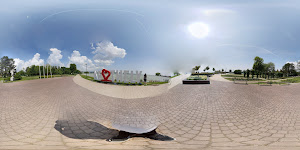Gabonatároló - horreum római rom - Keszthely
3.2/5
★
based on 6 reviews
Contact Gabonatároló / horreum római rom
| Address : | 8360 Hungary |
| Categories : |

|
S
|
Szabó Csaba on Google
★ ★ ★ ★ ★ Balatonkerülő bringatúra során vetődtem erre. A romokat benőtte a gaz, nehezen megközelíthető.
I threw myself into this during the Balaton bypass bike tour. The ruins were overgrown with weeds, difficult to access.
|
|
F
|
Ferenc Szabó on Google
★ ★ ★ ★ ★ Érdekes maradványok, kár hogy semmilyen információs tábla nincs kihelyezve
Interesting remains, it is a pity that no information board is placed
|
|
G
|
György Takács on Google
★ ★ ★ ★ ★ A IV. században épült római erődítményből ma a kapu, a háromhajós bazilika /ókeresztény típusú/ és az állami raktár maradványainak felfalazott építményei látszanak. A negyedik század második harmadában. Ekkor építették ki Valcum, azaz Keszthely-Fenékpuszta erődjét. A népvándorlás során az erődöt szinte mindig lakták, érdekes leleteket találunk így a kontinuitásról, a romanizált, antik kultúrájú lakosság tovább éleséről. Az erőd legközelebb a 18. századi térképeken tűnik fel, majd 125 éve megkezdték az első ásatásokat is. Egy háromszázhetvenhétszer háromszázötvennyolc méteres alapterületű, negyvennégy kerek toronnyal védett erődvárost hoztak létre, amelynek huszonkét épületét sikerült a huszadik században feltárni, ma a kapu, a háromhajós bazilika és az állami raktár maradványainak felfalazott építményei látszanak.Az erődváros annyira jól védhetőnek bizonyult, hogy lakosai helyben maradtak a rómaiak távozása után is. 456-tól a keleti gótok székhelye lett a település, később az avarok germánokat és bizánciakat telepítettek ide. 630 táján ugyan elhagyták a lakók a várost, ám a nyolcszázas években ismét beköltöztek az oltalmazó falak közé. A települést végül a 10. század elején a honfoglaló magyarok pusztították el.
A IV. Today, from the Roman fortress built in the 16th century, the walled walls of the gate, the three-aisled basilica (early Christian type) and the remains of the state warehouse can be seen. In the second third of the fourth century. It was then that the fortress of Valcum, ie Keszthely-Fenékpuszta, was built. During the migration, the fortress was almost always inhabited, so we can find interesting finds about the continuity, the further sharpening of the Romanized, antique culture population. The fort first appears on 18th-century maps, and then the first excavations began 125 years ago. A fortress town of three hundred and seventy-seven times three hundred and fifty-eight meters, protected by forty-four round towers, was built, twenty-two of its buildings were excavated in the twentieth century, and today the gate, the three-aisled basilica, and the remains of the state warehouse are well-preserved. even after the departure of the Romans. From 456 the settlement became the seat of the Eastern Goths, later the Avars settled Germans and Byzantines here. Around 630, the inhabitants left the city, but in the eighties they moved back into the protective walls. The settlement was finally destroyed by the conquering Hungarians at the beginning of the 10th century.
|
|
B
|
Béla Nád on Google
★ ★ ★ ★ ★ A romok épphogy kikandikálnak a földből. Jó lenne az infotáblákat "frissíteni". Remélem ha a kiskastély felújjítását befejezik erre is sor keröl!
The ruins are just peeking out of the ground. It would be good to "update" the info boards. I hope that when the renovation of the small castle is completed, it will take place!
|
|
E
|
Edit Hegedüs on Google
★ ★ ★ ★ ★ Sokkal több figyelmet és persze pénzt (ráfordítást), törődést érdemelne a hely. A romok szinte alig láthatóak, benőtte gyom, a fű, sajnos.
The place deserves a lot more attention and, of course, money (expenditure) and care. The ruins are almost barely visible, overgrown with weeds, grass, unfortunately.
|
|
S
|
Steve Caruana on Google
★ ★ ★ ★ ★ Nothing special to see
|
Write some of your reviews for the company Gabonatároló / horreum római rom
Your reviews will be very helpful to other customers in finding and evaluating information
Nearby places in the field of Tourist attraction,
Nearby places Gabonatároló / horreum római rom





















